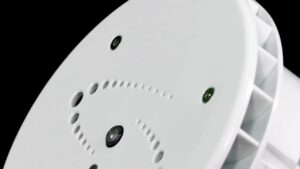An All-In-One Health, Safety And Vape Detector
Ideal for Schools, Public Spaces and Hospitality Venues
- Worried about vaping among young people within your school environment? A smart vape detector could help you manage this.
- Do you think there are people vaping or smoking marijuana in your hotel? A vape sensor that will detect THC would make all the difference.
- Are you concerned about the risk of airborne disease? Detection of temperature and humidity as well as particulates and droplets in the air could help you keep your building safer.
- Concerned about the health effects of poor indoor air quality? A sensor that will detect gases such as carbon monoxide and carbon dioxide would help you manage this.
- Looking for a way to deal with bullying or other aggressive behaviour among students? A sensor that would pick up abnormal noise levels and keywords such as a call for help would be useful.
- Unsure about the effectiveness of your heating, ventilation, and air conditioning system? A detector that picks up dangerous gases, particulates and humidity will help manage this.
The Halo Smart Sensor is a smart vape detector, and a health and safety monitor all in one
Vaping, Poor Air Quality and Aggressive Behaviour
Growth of Vaping
In the UK the selling of vaping devices or e-cigarettes to anyone aged under 18 and buying vaping products for anyone under 18 are prohibited. However, vaping among young people has become increasingly common with Office of National Statistics figures showing that the total proportion of young people aged 16 to 24 years who were daily or occasional vapers in 2022 increased to 15.5% compared with 11.1% in 2021. Figures from the public health charity ASH show that by 2024 vaping had reached 11% of the adult population of Great Britain.
Risks of Vaping
ASH says there is now well-established evidence that vaping is an effective aid to quitting smoking and is less harmful than smoking. However, the message from health professionals is clear if you have not smoked you should not vape and the long-term health impact for young people is not clear. However, there have been well-reported cases of hospitalisations. To compound this there are also now added risks from young people vaping THC vapes, as well as vapes laced with spice, an addictive synthetic street drug. Both are illegal in the UK and spice, in particular, is potentially dangerous and hospitalisations have been reported. Schools are at the forefront of dealing with the problems around vaping. This guide indicates how they can tackle vaping among their students effectively.
Supporting a range of sectors
Education: Managing a school or college means protecting and safeguarding all pupils. Read this guide to find out more.
Hospitality: If you manage a hotel, holiday park or restaurant/bar you want your guests to have stay in a clean and healthy environment.
Commercial: Helping to protect your staff, contractors, customers, or other visitors.
Healthcare/ Residential care: You need to ensure that staff, patients, residents and visitors are kept safe and are not behaving in a way that could harm other people.
Poor Indoor Air Quality
Indoor air pollution is dust, dirt, or gases in the air inside buildings such as your home or workplace that could be harmful to breathe in. Mismanagement of indoor air quality can have physical short and long-term consequences. Short-term effects include coughing; eye irritation; headaches and allergic reactions. Additionally, poor indoor air quality has been linked to lung diseases like asthma, COPD and lung cancer, as well as increased risk of heart disease and stroke, according to UK charity Asthma + Lung UK. The charity says that children are particularly vulnerable to poor indoor air quality as their lungs are still developing. Children’s airways are smaller, so inflammation caused by indoor and outdoor air pollution can cause them to narrow more easily than in older people.
Aggressive Behaviour
Bullying and fighting within schools can affect children’s mental health and as well as cause actual physical harm. In hospitality venues and hotels, there can be a risk of aggressive behaviour if there is excessive alcohol consumption. Therefore loud noise detection could help in challenging situations so staff take timely action and protect children and others.
Features of HALO Cloud
HALO Cloud offers an online dashboard where you can manage multiple devices, receive real-time and see alerts and historical data:
- Live View
- Device Health
- Analytics
- Reports
- Maintenance
“After the initial success with the first Halo Vape Sensor we had installed, the pupils have moved location which was always going to be the case. We would now like another one installed in one of the female toilets. The system is working well, we are really pleased.”
IT Manager
College in the South-West
Excellent service, ordered a number of [vape] detectors from Ecl-ips, they delivered them exactly when needed, configured them prior to delivery and made it easy for us to just plug and play the devices. Will be ordering more from them in the future.
Matt Crofts
Senior IT Technical and E-Learning Manager Brockhill Park Performing Arts College
The benefits of the Halo Smart Sensor: Vape detection, THC detection and much more
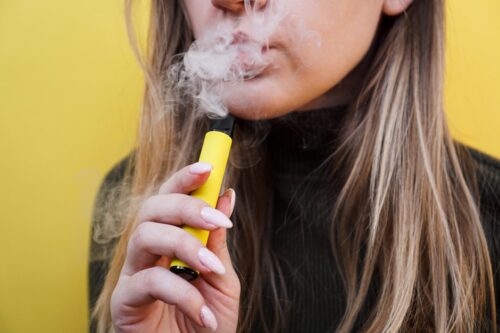
Vape and THC detection
The key features of the HALO Smart Sensor that ensure you can detect all vaping are:
- Ability to detect all features of vapes, including heat not burn
- Vape Notification (via email) in less than 8 seconds
- THC (cannabis) detection
- Mask detection, so vaping will still be detected even if people trying to cover it up, for example by using aerosols

Health Monitoring
The Health Index provides a real-time indication of the potential risk for the spread of airborne infectious disease in a building:
- Carbon Dioxide (CO₂)
- Particulate Matter (1 μm, 2.5 μm, 10 μm)
- Humidity (RH)
- Volatile Organic Compounds (VOC)
- Nitrogen Dioxide (NO₂)

Air Quality Monitoring
The factors detected for the air quality index are:
- Particulate Matter (2.5 μm, 10 μm)
- Carbon Monoxide (CO)
- Nitrogen Dioxide (NO₂)
Allowing facilities managers, and others, to take action to improve indoor air quality within their building.

Aggression Detection
The HALO can learn to detect abnormal noise levels. The HALO device also comes preloaded with five spoken keyword phrases related to calls for help giving people added protection.

Halo 3C Features
- Emergency Escape and Alert Lighting
- Motion Detection
- Panic Button
- Occupancy and People Counting
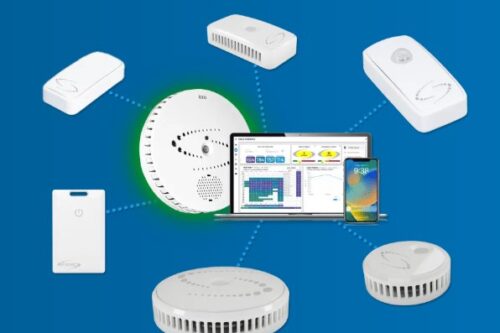
Halo Amplify
HALO Amplify – the Connected Sensor Suite – extends the security, health, and situational awareness of the HALO Smart Sensor 3C and 3C-PC. The solution includes panic buttons, people counting, temperature/ humidity and water leak sensors.

BBC Radio H&W features Halo
Interview with Aaron and Nicky
Listen to the BBC report

Sunday Times focus on vape detection
Aaron spoke to Megan Agnew
Read the article

Black Country Radio’s spotlight on vaping
Aaron chatted to Steve Parker
Listen to the conversation
Updates on the HALO
Health index enables facilities managers to make better decisions
HALO Amplify: supporting building protection
HALO Smart Sensor latest model available for purchase
Halo Smart Sensor: Benefit of the Events Log
Installing the HALO: Money saved in the long-term
How can you detect vaping? Smart sensors can help
Abnormal sound detection: Halo Smart Sensors do not record audio
HALO Smart Sensor: high quality but no subscription needed
Protecting students: Detecting anti-social behaviour and aggression
St Joseph’s: Convinced of the value of vape detection
Vape Detection in schools: Ensure you get an accurate sensor
Vape detection and more: Check out the Halo Smart Sensor 3C
Vape detection: Choose the HALO Smart Sensor
Getting the most out of the HALO
Why choose the HALO? Its advantages over other smart sensors
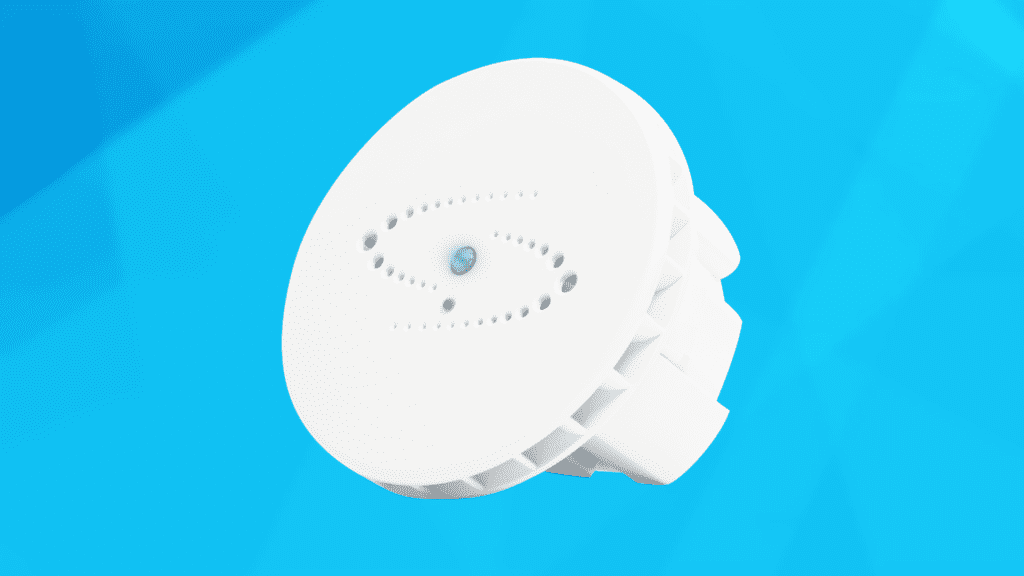
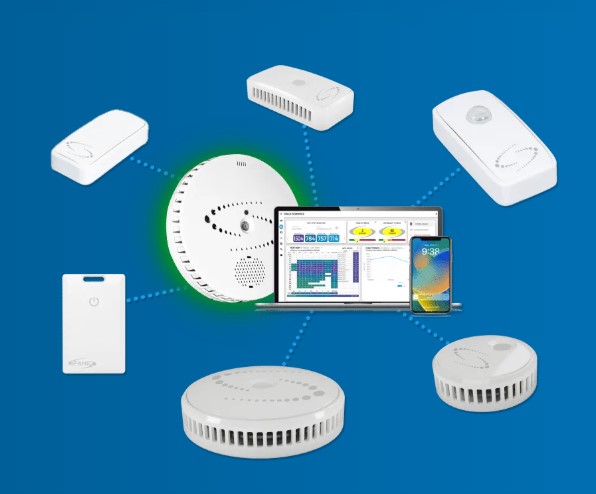

Contact us for a Free Demo of the HALO Smart Sensor
Your information will only be used to make contact with you about this enquiry. The data in this form will be sent to us over email.
Frequently Asked Questions
Where can you use the HALO Smart Sensor?
The HALO Smart Sensor can be placed in a range of indoor locations where you need vape detection or you’re looking to protect students, staff, visitors or guests. The vape detectors/vape sensors can be installed in private areas, such as washrooms, changing rooms where you may believe student vaping is taking place, staff rooms or guest bedrooms. Therefore, they are ideal for buildings such as hotels, schools, colleges, educational institutions, commercial offices, hospitals, manufacturing plants or residential care homes.
Do I need HALO cloud for the Smart Sensor to work?
No, this is an optional extra as HALO is an intelligent sensor and can be used as a standalone device.
Who manufactures the HALO Smart Sensor?
The HALO Smart Sensor is the newest product manufactured in the USA by IPVideo Corporation. This company harnesses the power of the Internet of Things (IoT) and incorporates artificial intelligence (AI) and machine learning to deliver a range of open platform physical security, sensor and audio/visual solutions. It aims to design and manufacture solutions for a smarter and safer world! IPVideo Corporation is a subsidiary of Advance Convergence Group.
Does the HALO Smart Sensor come with a warranty?
IPVideo Corporation provides a two-year warranty. If you encounter any problems with the HALO smart sensor you need to inform us as soon as possible and we will either arrange a repair of the HALO Smart Senor or a replacement of the product will be offered. Multi-year extended warranties are sold separately.
Who can install the HALO Smart Sensor?
The HALO Smart Sensor is a new product in the UK market and the Ecl-ips team is one of the few trained installers. As an experienced security systems specialist we can not only install the HALO Smart Sensor but can also integrate the sensor to the rest of your security system and ensure it is installed in the proper location.
Will the HALO Smart Sensor work out of the box?
HALO does work right out of the box since its recent firmware update. Ecl-ips will take care of setting up the HALO Smart Sensor for you, including ensuring the firmware is always up to date and that all your requirements for detection are set up correctly. Once HALO is powered on, it requires 24 hours for the sensors to self-calibrate.
Can a vape detector reduce vaping in schools?
When combined with a robust policy on smoking and vaping; trained staff who can deal with those vaping and ongoing student education, a vape detector like the Halo Smart Sensor, can reduce vaping in schools. We have case studies from Baxter College in Worcestershire and St Joseph’s College in Staffordshire that outline how effective the HALO has been. To find out more read our guide on vaping in schools outlining the problem and how to solve it.
Is this vape detector a useful school safety device?
The Halo can a useful school safety device through its monitoring of vaping allowing you to protect students. However, it can also detect poor ventilation and dangerous gases through its air quality and health monitoring.
How effective are vape detectors in schools?
Vape detectors, particularly the HALO Smart Sensor we offer, are effective and work to reduce vaping in schools. The HALO uses a dynamic vape detection algorithm to automatically learn the environment and alert when vaping is detected. The HALO is also the only product that can alert and differentiate between vaping, vaping with tetrahydrocannabinol (THC) which is found in cannabis, and intentionally masking vaping behaviour, for example, by using aerosols to cover up vaping. The Halo Smart Sensor is also the only sensor on the market that can detect ‘Heat Not Burn’ vapes, ensuring the Halo can detect ALL varieties of vapes. To find out more please read our guide for schools.
How can we prevent vaping in schools?
Vape detectors, particularly the HALO Smart Sensor we offer, can help to prevent vaping in schools. The HALO uses a dynamic vape detection algorithm to automatically learn the environment and alert when vaping is detected. The HALO is also the only product that can alert and differentiate between vaping, vaping with tetrahydrocannabinol (THC) which is found in cannabis, and intentionally masking vaping behaviour, for example, by using aerosols to cover up vaping. The Halo Smart Sensor is also the only sensor on the market that can detect ‘Heat Not Burn’ vapes, ensuring the Halo can detect ALL varieties of vapes. To find out more please read our guide for schools.
What could schools do to stop vaping?
If schools want to stop vaping they should develop a robust policy on smoking and vaping; they need trained staff who can deal with those vaping and ongoing student education. Additionally installing a vape detector like the Halo Smart Sensor, can help to stop vaping in schools. We have case studies from Baxter College in Worcestershire and St Joseph’s College in Staffordshire that outline how effective the HALO has been. To find out more read our guide on vaping in schools outlining the problem and how to solve it.
Does the Halo have a tamper siren to protect against vandalism?
The HALO has a tamper alert, which can be an email notification or an audible tamper siren.
Can you receive HALO notifications through text alerts?
The easiest way for us to set up the HALO and for you to receive notifications from the HALO is via email but with further integration text alerts are possible.
Will the HALO detect cannabis/marijuana?
The HALO detects high levels of ammonia which means it can accurately provide you an alert for THC, which is the chemical component found in cannabis. This means it can detect THC when added in oil for vapes but also within cannabis/marijuana smoke.
What are the additional features within the HALO 3C?
Emergency Escape and Alert Lighting: LED coloured lighting options that can be programmed to show escape routes for safety such as a red, yellow, and green pattern. You can create unique colours for different alerts such as purple for Air Quality alerts or blue for Health alerts. The lights themselves are projected onto the ceiling around the HALO for extended visibility.
Motion Detection: Identify and alert on movement for occupancy and trespassing.
Panic Button: Users can trigger alerts via an external 3rd party panic button or via the HALO cloud app. The location of the trigger is associated to the HALO device in closest proximity.
Occupancy and People Counting: Identify how many people are within the HALO location and configure to alert on abnormalities. (Only available on HALO 3C-PC)
5 year warranty
What are the benefits of the improved HALO Cloud and the new HALO app?
Allows users to receive push notifications of any HALO alert, trigger a panic button, and provide the indoor air quality information of the actual room being occupied.
Will a smoke detector detect vaping?
A smoke detector may be able to detect higher levels of vapour in the air but it won’t be able to differentiate between this or smoke from a fire. This has led to some schools being inconvenienced because they initiate a full evacuation of the school and this has happened several times before they understand the reason for the alarm being triggered. The HALO Smart Sensor now can detect smoke as well as being an accurate vape sensor so schools can take the correct measures based on the alert received.
Deleted:
I've got an air quality sensor with a Tuya App, what does that mean?
It means you have to use the Tuya app for the entire lifecycle of the device to enable it to connect and operate. You will also need Wi-Fi, so wherever you install the sensor you will need an excellent Wi-Fi connection at all times to ensure the sensor can operate. This also means that the sensor will be connected to your Wi-Fi network leaving you vulnerable from an IT security aspect. Most of the devices are 2.4GHz so if you have a 5GHz Wi-Fi network they will not connect.
What does the term PM2.5 Laser Scattering Sensor mean?
Particulate matter, or PM, is a mix of particles and droplets in the air. PM varies in shape and size, but those of 10 micrometers in density or smaller can adversely affect your health because they can be inhaled. PM 2.5 refers to fine particulate matter – with a density of two-and-one-half microns or less.
Deleted: Sufficient exposure to PM can irritate the eyes, nose, throat and lungs, leading to allergy-like symptoms and shortness of breath in otherwise healthy people. It can also exacerbate existing medical problems, such as asthma and heart disease. PM 2.5 is considered the world’s single biggest environmental health risk.
Deleted: Indoor PM levels can be influenced by outdoor sources like vehicle exhaust fumes, wildfires, and power plant emissions. But many indoor activities produce PM as well: cooking, burning fuels on fires or wood-burning stoves smoking are just a few common sources.
Do I need a subscription with the Halo Smart Sensor?
The quick answer is No. The Halo Smart Sensor will work perfectly well without any apps or other interventions, however if you do want to manage all of your devices in one place at one time there is a cloud subscription if you choose to use it.
Why do I need a tamper alert?
The tamper alert is very handy to have, you get notified the minute someone starts to mess with your device enabling you to go to the device and find out what is going on. There have been instances up and down the country of students ripping the devices off the ceiling and throwing them away and because they don’t have tamper alerts the schools have been none the wiser.
What does IK10 rating mean?
The Halo Smart Sensor is vandal resistant and has an IK10 rating, so whilst it’s sleek in its design it is also extremely hardy and has undertaken various stress conditions to make sure it will withstand the toughest of conditions.
Why is the aggression alert useful?
The aggression alert will be activated when noise levels in the room rise which could be an indication of a fight due to break out or indeed vandalism about to take place. If a member of staff could attend the area you could stop a fight or indeed save money on repairs by stopping anything getting broken etc. No recording of the noise is made, the alert simply means that any incident of loud noise can be investigated.
What is a 'Heat not Burn' vape?
‘Heat not burn’ or ‘smokeless tobacco’ products are electronic devices that, unlike e-cigarettes, contain tobacco. The tobacco is heated to a high temperature, without setting it alight, and creating ‘smoke’ that the user sucks in. They contain nicotine, additives and are often flavoured. IPVideo Corporation announced in April 2022 that it was awarded three additional U.S patents for its HALO IoT Smart Sensor, which added Heat-Not-Burn (HNB) vaping detection to its protection portfolio. The heat not burn vapes will not be detectable by PM2.5 sensors or indeed any other devices apart from the Halo Smart Sensors.
Do vape detectors give false positives?
Vape detectors can give false positives but if the technology is robust these should reduce to nothing over time. The HALO Smart Sensor uses a dynamic vape detection algorithm to automatically learn the environment and alert when vaping is detected. This means you may receive some early false alerts but after this they should stop. If you have any issue we can support you. We pre-stage the HALO Smart Sensors before we send them to schools and then once the device is plugged in it will take 24 hours for the sensors to self-calibrate.
What is the difference between the Health Index and the Air Quality Index?
The Health Index provides a real-time indication of the potential risk for the spread of airborne infectious disease in a building while the Air Quality Index is a measurement of air quality based on a scale developed by the US Environmental Protection Agency (EPA). As detailed below they are produced through a range of factors being detected and there is an overlap in those used for the indices.
To provide the information for the health index the HALO detects:
Carbon Dioxide (CO₂): Higher levels of this gas can be an indication of an unhealthy indoor space as people naturally breathe out this gas and high concentrations will occur when areas are too crowded and there is poor ventilation.
Particulate Matter (1 μm, 2.5 μm, 10 μm): This is a mix of particles and droplets in the air. PM sized 10 micrometres or smaller can be considered to be a risk to health as they can be inhaled but additionally high concentrations can indicate the presence of infectious diseases.
Humidity (RH): if the humidity is high the air feels warmer than the official, recorded temperature and it can contribute to feelings of low energy and lethargy.
Volatile Organic Compounds (VOC): These are gases emitted from a variety of materials that can have short- and long-term health effects and tend to be found in higher concentrations inside.
Nitrogen Dioxide (NO₂): High levels of nitrogen oxide are associated with respiratory diseases and higher prevalence of asthma, which can result in hospital admissions.
The factors detected for the air quality index are:
Particulate Matter (2.5 μm, 10 μm): Many indoor activities produce particulate matter: cooking, burning fireplaces, and smoking are just a few common sources.
Carbon Monoxide (CO): This is an odourless, colourless gas which in high concentrations can be deadly.
Nitrogen Dioxide (NO₂): This gas occurs naturally but can be increased by human activity, primarily through the combustion of fossil fuels.
What are VOCs?
Volatile Organic Compounds (VOC): These are gases emitted from a variety of materials that can have short- and long-term health effects and tend to be found in higher concentrations inside. Short-term exposure to low levels of VOCs can cause throat irritation, nausea, fatigue, and other minor complaints. Long-term exposure to high concentrations of VOCs has been linked to more severe respiratory irritation as well as liver and kidney damage.
Sources of VOCs include many common products, including cleaning fluids, disinfectants, paints, and varnishes. Burning fuels like wood and natural gas also produce VOCs. Products can emit VOCs even when they’re in storage, though to a lesser extent than when they’re actively being used.


